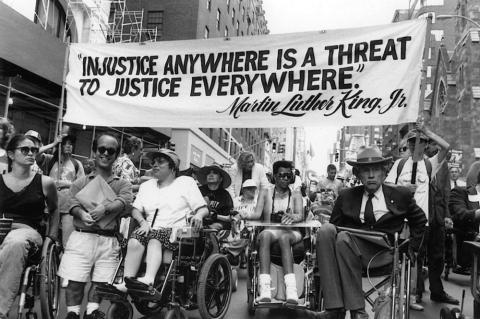Members of Disabled Americans Want Work Now will join in the celebrations of the 25th anniversary of the Americans with Disabilities Act on Saturday. Then they’ll go back to their work seeking to increase employment opportunities—and decrease poverty levels—among people with disabilities.
A community organizing project of Access Living, DAWWN includes people with a variety of disabilities from communities across the city. The group is currently working to keep the state from backtracking on commitments and to encourage the city to do more to improve access to jobs, said organizer Rene David Luna.
The ADA banned discrimination against people with disabilities and—along with grassroots activism that often involved civil disobedience—led to increased access to public transportation and to public buildings and services.
“There’s progress in civil rights, but economic progress is lacking,” said Luna. “Poverty rates are tremendously high, the employment gap is tremendously high. It’s similar to what other communities face—you win civil rights protections, but then what?”
Only 20 percent of people with disabilities are in the workforce. Working-age people with disabilities had a poverty rate of 28.4 percent in 2013—more than double that of the rest of the population.
Poverty and disability are closely linked, with one study showing that two-thirds of people in poverty long-term have a disability. Disability is both a cause and a consequence of poverty, according to Rebecca Vallas and Shawn Fremstad of the Center for American Progress: a cause because of barriers to employment and education, reduced earnings and additional living expenses; a consequence because poor people have less access to health care and preventive services and a greater chance of working in environments where their health and safety is at risk.
“Disabled people tend to live in the poorest areas with much less access to jobs and good education, said Luna. “There are a lot of obstacles. It’s the kind of social issue that isn’t being addressed—when we talk about poverty, we don’t talk about people with disabilities.
The problem is multilayered, Luna said. “For working-class people, as we get older, accidents happen, illnesses, you may have to take a leave and go on disability. Getting back into the workforce can be really hard.” If you end up trapped in a nursing home after an injury or illness, it’s doubly hard, he said.
The city needs to undertake a thorough evaluation of its policies and programs, said Luna. He points to the state’s Task Force on Employment and Equal Opportunity for Persons with Disabilities as a possible model. The task force was instrumental in pushing through legislation shifting state support away from sheltered workshops which pay sub-minimum wages—some as little as $2 a day—and toward integrated employment.
Now Gov. Bruce Rauner seems to be backing away from that commitment, Luna said. Rauner has also cut funding for home services for people with disabilities, and his cuts to Medicaid have limited the availability of durable medical equipment such as wheelchairs.
A city task force that concluded its work 10 years ago made some advances – winning inclusion of people with disabilities in the city’s contracting program for minority-owned businesses—“but left a lot undone,” Luna said.
He’d like to see a thorough evaluation of the city’s record in addressing new U.S. Department of Labor regulations requiring federal contractors to recruit and hire people with disabilities at above the minimum wage. (DOL set a goal that 7 percent of federal contractors’ workforces should be people with disabilities.) How are city contractors on federally-funded projects doing?
And much more is needed to improve physical accessibility in the city’s neighborhoods. Luna believes city collaboration with local business groups and community development agencies could improve physical access to small businesses as well as access to jobs.
“We need to get the numbers up,” he said. “What is the city doing to help?”
Public officials are likely to tout their accomplishments in advancing disability rights in the next few days—and good for them. But there’s more to be done.


Spread the word